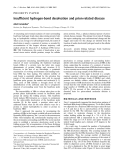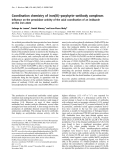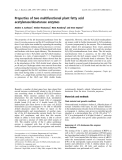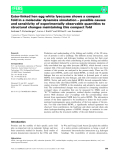
Atoms and bonding
-
Department of Chemistry ‘IFM’, University of Torino, Italy; 2Department of Biology, University ‘Roma Tre’, Rome, Italy; 3Department of Structural and Functional Biology, University of Insubria, Italy Haem binding to human serum albumin (HSA) endows the protein with peculiar spectroscopic properties. Here, the effect of ibuprofen and warfarin on the spectroscopic properties of ferric haem –human serum albumin (ferric HSA–haem) and of ferrous nitrosylated haem –human serum albumin (ferrous HSA –haem-NO) is reported.
 7p
7p  system191
system191
 01-06-2013
01-06-2013
 46
46
 3
3
 Download
Download
-
A structuring and eventual exclusion of water surrounding backbone hydrogen bonds takes place during protein fold-ing as hydrophobic residues cluster around such bonds. Taken as an average over all hydrogen bonds, the extent of desolvation is nearly a constant of motion, as revealed by re-examination of the longest all-atom trajectory with explicit solvent [Y.Duan & P.A.Kollman (1998)Science 282, 740].Furthermore, this extent of desolvation is pre-served across native soluble proteins, except for cellular prion proteins....
 4p
4p  research12
research12
 23-04-2013
23-04-2013
 33
33
 2
2
 Download
Download
-
An arti®cial peroxidase-like hemoprotein has been obtained by associating a monoclonal antibody, 13G10, and its iron(III)±a,a,a,b-meso-tetrakis(ortho-carboxyphenyl)por-phyrin [Fe(ToCPP)] hapten. In this antibody, about two-thirds of the porphyrinmoiety is inserted in the binding site, its ortho-COOH substituents being recognized by amino-acids of the protein, and a carboxylic acid side chain of the protein acts as a general acid base catalyst in the heterolytic cleavage of the O±O bond of H2O2, but no amino-acid res-idue is actingas anaxial ligandof the iron....
 11p
11p  research12
research12
 23-04-2013
23-04-2013
 35
35
 2
2
 Download
Download
-
The properties of theD6 desaturase/acetylenase from the mossCeratodon purpureusand theD12 acetylenase from the dicotCrepis alpinawere studied by expressing the encoding genes inArabidopsis thalianaandSaccharomyces cerevisiae. The acetylenase fromC. alpinaD12 desaturated both oleate and linoleate with about equal efficiency. The desaturation of oleate gave rise to 9(Z),12(E)- and 9(Z),12(Z)-octadeca-dienoates in a ratio of approximately 3 : 1.
 0p
0p  awards
awards
 05-04-2013
05-04-2013
 41
41
 3
3
 Download
Download
-
Prediction and understanding of the folding and stability of the 3D struc-ture of proteins is still a challenge. The different atomic interactions, such as non polar contacts and hydrogen bonding, are known but their exact relative weights and roles when contributing to protein folding and stability are not identified.
 17p
17p  cosis54
cosis54
 08-12-2012
08-12-2012
 43
43
 2
2
 Download
Download
CHỦ ĐỀ BẠN MUỐN TÌM


















